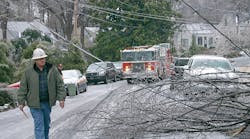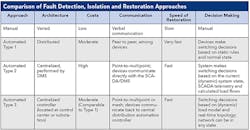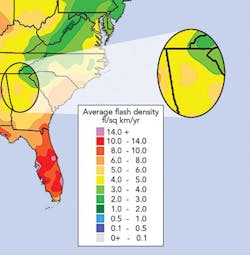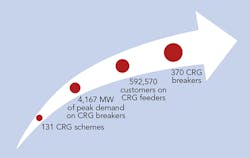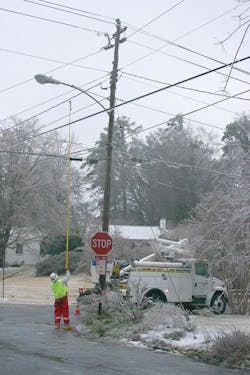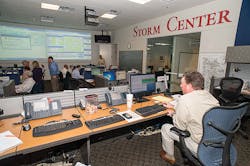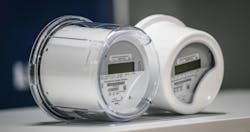Georgia Power Implements Centralized Restoration Gateway
The rollout of a centralized fault isolation and restoration solution across Georgia Power’s service territory has enabled deployment of key smart grid functionality in a scalable and cost-effective manner. As a result of this successful implementation, current plans call for the continued deployment of this solution across additional portions of Georgia Power’s distribution system.
The most densely populated portion of Georgia Power’s service territory lies in the middle of the largest urban forest in the United States. The entire state’s above-average forestation includes a high portion of relatively weaker pines, which increases the destructiveness of storms, particularly the damage to overhead lines from falling trees and limbs. Although Atlanta, Georgia’s, beautiful tree canopy provides a beneficial cooling effect, this very effect also has been shown to increase the incidence of thunderstorms, because evaporation from forested areas creates cooler air, which interacts with heat rising from roads, parking lots, rooftops and other hard urban surfaces nearby.
For electric utilities, these micro-climate conditions aggravate load management by triggering afternoon thunderstorms, often during the worst possible times — on the hottest, most humid summer days in the late afternoons or early evenings near the time when electric demand typically peaks. As a result, Atlanta’s urban forest was an important factor increasing Georgia Power’s sense of urgency to minimize outages and speed restoration.
Self-Healing Network Wish List
In 2010, Georgia Power set out to increase reliability and add a wide spectrum of functionality to legacy feeder and distribution automation systems. Key goals of the project were to overcome the uncertainty of what might happen in emergency conditions and to deploy the best fault detection, isolation and restoration (FDIR) technology possible. In collaboration with distribution automation engineers and a group of T&D executives, the project team sat down and defined its must-haves:
• It must be safe. Technology needs to prohibit automatic restoration for any abnormal function switch or device health.
• It must ensure system stability by requiring manual restoration during system emergency events and operator initiation for transmission events.
• It must increase functionality by gathering fault data from all intelligent electronic devices (IEDs) and sending the device status directly to the outage management system/distribution management system (OMS/DMS).
• It must deliver enhanced reporting by producing reports that allow easy calculation of customer minutes of interruption (CMI) avoided.
• It must work with existing infrastructure by detecting faults and performing restoration without having to replace field IEDs as well as be compatible with legacy communications systems.
To meet this list of must-haves, the team explored many options for automated fault detection.
While not universally deployed, forms of FDIR have been available since the late 1990s, when they first emerged, offering fast but often pricey alternatives to the traditional method of manual restoration. Automated FDIR enabled greater speed and responsiveness, often reducing restoration times from hours to mere minutes. It was a big step forward for those who could afford to move away from manual methods, which rely on a vigilant human operator to detect problems and react with switching decisions based on sometimes-incomplete data.
The family tree of FDIR soon branched into two divergent approaches to automation: the distributed, rules-based system or the centralized, model-driven system. Utilities choosing the first approach — a distributed, rules-based system — enjoyed relative ease of deployment but lacked the power and flexibility needed to deal with multiple fault occurrences, hardware from multiple vendors and changing needs over time. With grid complexity and the ever-increasing deluge of data in the smart grid era, the limits of this approach were eventually exposed. Utilities choosing the second approach — a centralized network model — found a more robust solution, but one that often proved expensive and time-consuming, both to install and to maintain.
The Georgia Power team researched the technology and came to an agreement on the type of solution desired, namely, one that would provide the benefits of both approaches. The project was dubbed Centralized Restoration Gateway (CRG) within Georgia Power, indicating the preference for a self-healing option that would use centralized intelligent control.
Best of Both Worlds
Georgia Power began to look at a new solution for FDIR from Advanced Control Systems (ACS) that offered many of the advantages of the two historically distinct approaches. It used a variety of predefined network topology templates containing multiple automated devices that could be activated or ignored to match the actual network architecture. This simplified island-based configuration method could readily adjust to future growth, a change in equipment or a different set of priorities without a great deal of extra effort. The Georgia Power team was intrigued by the promise of both the performance and rapid deployment typical of a distributed solution combined with the power and reliability of a dynamic, model-driven approach.
Testing the Technologies
After a comprehensive evaluation of available FDIR solutions, two finalists were selected for an extensive side-by-side comparison. The detailed comparative pilot project was very high profile because it received funding from a Smart Grid Investment Grant (SGIG).
The evaluation focused on determining how best to improve network reliability and add self-healing network capabilities in the most economical fashion using Georgia Power’s existing communications and control infrastructure. The competing solutions were both automated but based on different design philosophies, with one relying on a distributed architecture and the other being centralized.
Decision Point
The project team recommended Georgia Power go with the Centrix solution from ACS because it is model based but did not have the configuration complexity normally associated with creating a network model. The utility assessed the purchase and installation costs of this solution as comparable to that of a distributed system. Yet, by virtue of operating from a true network model, the solution offered the ability to incorporate existing devices easily — freeing the utility from vendor-specific hardware — as well as the ability to add other applications, such as loss minimization and integrated volt/VAR, later, if desired.
Because of the success of the pilot program with the centralized FDIR platform, the peer-to-peer solution already in use in some portions of the Georgia Power system is being phased out gradually. One reason for this is the existing peer-to-peer system needed a direct line of site for the controls to communicate effectively with one another, resulting in frequent problems keeping devices on-line. Fundamentally, this new approach is not only more reliable for Georgia Power, but the total cost of ownership also is expected to be much lower, in part, as a result of lower ongoing maintenance costs.
Deployment Timeline
The first of the CRGs using Centrix went on-line in December 2011 in Albany, Georgia. After an extended pilot phase and utility-wide training program, the rollout to other portions of the Georgia Power system began in earnest in 2013, with 174 feeders automated by October 2013. The system currently includes 370 feeder breakers and more than 1,452 automated devices.
Results and Lessons Learned
Fundamentally, the isolation of outages with the system is one of the main benefits. Another benefit is a more rapid response. Even if an outage is basically the same size as it would have been in the past, with the new CRG solution, it is addressed in seconds automatically through intelligent switching commands after fault detection and isolation. Significant performance and reliability improvements were observed as a result of the new system — before, during and after unusually severe ice storms during the winter of 2013/2014. Outage response improvements during summer storms were particularly significant, as well.
Instead of completing restoration operation in a matter of one or two minutes under the new system, it may have taken 15 minutes or longer to isolate a fault using information from the OMS, which would require determining an appropriate switching plan and then manually issuing the commands from supervisory control and data acquisition. In greatest contrast, isolating the same outage in areas without automation previously took as much as two or three hours, as a crew would have to be dispatched to perform the operations. Obviously, the technology enabled Georgia Power to significantly reduce the frequency of sustained outages and the impact of outages when they do occur, with most customers only experiencing a momentary loss of power when a fault occurs.
Performance to date has been excellent. In terms of quantifiable measures, Georgia Power has reported improvement in reliability tracking numbers, the system average interruption duration index (SAIDI) and system average interruption frequency index (SAIFI). For perspective — when applying a standard U.S. Department of Energy-approved calculation to the operational results of the improvements — in 2014 alone, cumulatively more than 7.2 million CMI were avoided as of August 2014. Even though the system has not been fully deployed yet across Georgia Power’s 2.3 million customer base, the significance of the 7.2 million minutes of outages avoided is equivalent to avoiding a one-hour outage for 120,000 customers, or more than half a million customers not having a 14-minute outage.
One of the biggest additional benefits of the system, automatic centralized restoration frees up operators during multi-event situations. This enables them to make better decisions — increasing effectiveness, efficiency and reliability of their actions; managing big-picture strategies; and coming up with even greater ideas for improvements — while being able to address more detailed matters as needed. If operators were still bogged down with having to assess outages and make many switching decisions during emergencies, they would not be able to engage in the higher-level value-added (and reliability- and safety-added) activities.
Georgia Power’s approach has gained a positive and high-profile reception not only with the utility’s executive management, engineering, and network operators and dispatchers, but also in the larger customer community and stakeholder communities, including Georgia’s governor. Georgia Power’s work has been very successful, and the utility has entertained neighboring utilities who have been interested to learn more about the success of the CRG project.
Benefits for Wider Community
Safety benefits and stronger relationships are associated with the CRG for customers in the service territory as well as with the wider community. For example, Georgia Power has provided operational training for the new FDIR technology on the utility’s distribution system with all engineers and field employees. In addition, the organization took that training to a new level when the distribution group provided training not only to its construction coordinators but also to about 160 contractors. The contract foremen and linemen represent 20 companies that work daily with the utility’s distribution control center to operate the distribution system correctly while keeping their employees safe.
In addition to direct employees at Georgia Power, the utility also wanted its contractors to be aware of the automation changes being made to improve reliability and customer satisfaction. The training became an opportunity to share information face to face about the new system, the project goals and working safely.
Craig Walker ([email protected]) is a distribution automation test engineer with Georgia Power, where he has worked for more than 17 years. He has led the implementation and staff training for Georgia Power’s Centralized Restoration Gateway project on advanced distribution automation technology. Walker has a BSEE degree from Auburn University, and is a registered professional engineer and a licensed electrical contractor.
Mentioned in this article:
Advanced Control Systems | www.acspower.com
Georgia Power | www.georgiapower.com
